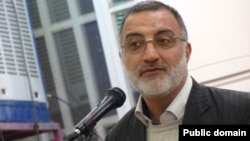Recent disclosure of major financial corruption cases in Iran appear to have caused colossal collateral damage to the hard core of the Islamic Republic while also ruining the political future of several key regime insiders.
Top clerics have condemned disclosures and mutual incrimination as "a disgrace for the clergy and the regime."
During the past weeks, two of the six jurisconsults (top ayatollahs) on the Guardian Council, one of the bodies most trusted by Supreme Leader Ayatollah Khamenei have accused each other of financial corruption and lack of Islamic knowledge, undermining each other and possibly the entire council's integrity.
The Intelligence Ministry, one of the most feared institutions in Iran, has been implicated in at least two major cases of financial corruption in the petrochemical industry, the Central bank and the forex market.
The corruption case involving former Judiciary Chief Ayatollah Sadeq Amoli-Larijani not only tarnished his own image as a cleric, but also threatened the political future of his brother, Parliament Speaker Ali Larijani, not to mention the damage done to Shiite Islam and its circle of trusted scholars (ulema), and to the reputation of Khamenei as the man who appointed Larijani in a position to protect everyone else's rights.
In the meantime, hardliner cleric Ayatollah Nasser Makarem Shirazi has called on the two belligerent ayatollahs, Yazdi and Amoli-Larijani, "to end this disgrace for clerics and the regime."
The hardliner editor of Kayhan newspaper, Hossein Shariatmadari also wrote that even if the accusations and counter-accusations are true, they will only disappoint the people and make the enemies of the Islamic Republic happy.
Even worse than the disputes being aired publicly is Khamenei's mysterious absence which has given rise to several hypotheses although he could appear any moment to silence possible rebels or damn possible law-breakers.
One hypothesis is that the disclosures are all his tricks to control the widespread systemic corruption fueled by the greed of the progeny of the Islamic Republic's elite. The presence of a character close to his office in the center of disclosures lends this hypothesis credibility.
This key character is Alireza Zakani, an ophthalmologist and a former lawmaker known for his hardline views, with a background of serving as head of the Basij militia at the Tehran University. Zakani has implicated the Intelligence Ministry in an alleged corruption case within the Petrochemical Industry, which has been partially sold to influential insiders.
The Ministry has already admitted its role in a $160 million alleged corruption case in the forex market and Iran's Central Bank last week. It is also charged with spiriting “criminals” out of the country's borders.
Zakani on Sunday added another accusation, saying there was more than six billion euros of corruption in the petrochemical sector, with the intelligence ministry involved.
On Monday, the ministry came out throwing its own punches at Zakani, saying he is protecting corrupt individuals. It seems there is no end to mutual incrimination.
Another evidence showing Khamenei's possible approval of the disclosures is the state-run TV which in an unlikely behavior has so far shown four programs that condemn Amoli-Larijani. One program shows a whole town of large mansions built on the hills in Tehran's affluent north allegedly developed by the cleric. The state-run TV is directly controlled by Khamenei’s office.
An equally strong hypothesis is that he has lost control over the rebels among the elite who kick and bite each other over political rivalry because of greed.
In yet another hypothesis, according to observers on social media and some players such as Larijani himself, is the rivalry between the IRGC Intelligence Organization linked to Khamenei's office, and the Intelligence Ministry, which is part of the Rouhani administration, both being responsible for the leaks about financial corruption.
And finally, there is theory of rivalry for succession to Khamenei, in which the Supreme Leader himself, or people around him, are supposedly eliminating candidates they do not want.
Strangely enough, there is some truth in every one of these and other sub-hypotheses, in a way that one could think of a combination of reasons for the ongoing developments. However, the disputes between two top clerics, Yazdi and Larijani, in which both sides present solid evidence to condemn each other, appears to be the most damaging to the essence of the Islamic Republic.
More than a few individuals have pointed out on social media that the Iranian brand of Islam, has been damaged as a result of top clerics' involvement in corruption.
Tehran-based journalist Yashar Soltani observed on Twitter that "the dispute between Larijani and Yazdi is not between two individuals. It is a conflict between two gangs in Iranian politics, who no longer see a powerful common enemy. So, they are fighting each other over financial gains."
Soltani said that it is regrettable that the two oversaw restoration of Justice in Iran for ten years each.
Yazdi and Larijani each headed Iran’s all-powerful and hardliner Judiciary or justice department for ten years.
Whether the disclosures are engineered to further a political agenda, as some say, or they have accidentally occurred within the space of a week, they have blurred the usual landscape of power and control. It is no longer clear who is in charge in Tehran. The resulting chaos can lead to unexpected developments.






